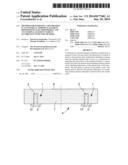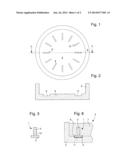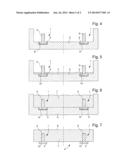Patent application title: METHOD FOR INSERTING A DECORATION IN AN EXTERNAL TIMEPIECE ELEMENT DEPOSITED BY ELECTROFORMING AND AN EXTERNAL ELEMENT MADE IN ACCORDANCE WITH THIS METHOD
Inventors:
Pascal Grossenbacher (Neuchatel, CH)
Pascal Grossenbacher (Neuchatel, CH)
Thomas Froelicher (Le Landeron, CH)
Assignees:
THE SWATCH GROUP RESEARCH AND DEVELOPMENT LTD
IPC8 Class: AG04D300FI
USPC Class:
368232
Class name: Displays or display device details dial or hand including dial details only
Publication date: 2014-06-26
Patent application number: 20140177401
Abstract:
To fabricate an external timepiece element in which there is inserted at
least one decoration, the decoration is formed of anterior and posterior
parts respectively intended to emerge from the external element and to
serve as a mechanism of anchoring the decoration in the external element.
A master mold is provided, the master mold including a hollow pattern
cavity matching dimensions of the anterior part of the decoration. The
decoration is placed in the pattern cavity. The master mold is filled by
the galvanic deposition of a metal. The external element obtained is
removed from the master mold.Claims:
1-9. (canceled)
10. A method of fabricating an external timepiece element in which at least one decoration is inserted, the method comprising: a) taking a decoration formed of anterior and posterior parts respectively intended to emerge from the external element and to serve as a means of anchoring the decoration in the external timepiece element; b) taking a master mold made in dimensions of the external element, the master mold including a hollow pattern cavity, and matching dimensions of the anterior part of the decoration; c) placing the decoration in the master mold, the anterior part of the decoration filling the pattern cavity made in the master mold; d) filling the master mold by galvanic deposition of a metal to obtain a required external element; and e) removing the external obtained timepiece element from the master mold.
11. The method according to claim 10, wherein c) is preceded by a chemical passivation of the master mold if the master mold is made of metal.
12. The method according to claim 10, wherein c) is preceded by a metallizing the master mold if the master mold is made of a non-electroconductive material.
13. The method according to claim 10, wherein the decoration is a metal.
14. The method according to claim 10, wherein the decoration is made of a non-electroconductive material.
15. The method according to claim 10, wherein a portion of a back of the anterior part of the decoration is held in the metal of the external element.
16. The method according to claim 10, wherein the posterior part of the decoration includes a retaining draft.
17. An external timepiece element according to the method defined in claim 10, wherein the element is a watch dial.
18. The external timepiece element according to claim 17, wherein the watch dial includes a plurality of decorations indicating hours.
Description:
[0001] The present invention relates to a method of fabricating an
external timepiece element into which at least one decoration is
inserted.
[0002] It has already been proposed to insert a decoration into an external timepiece element. EP Patent Application No 2192454A1 describes a decoration deposited by electroforming on an external element by means of a mask which is filled with a metallic material. This decoration may also include an anchoring means ensuring that the decoration is properly held in the element concerned, this anchoring means being also deposited by electroforming. It will be seen below that, in the present invention, it is the external element which is created by electroforming and not the decoration as proposed in the aforecited Patent Application.
[0003] It has also been proposed to fix a precious or artificial stone to a substrate made of cire perdue which is metallised and then coated with a metallic layer deposited by electroforming, said layer holding the precious stone in place. This method is disclosed in US Patent Application No 2008/0066310A1.
[0004] An electroplating deposition is also used to hold a precious stone on a base in U.S. Pat. No. 6,212,745B1.
[0005] Contrary to the teaching of the aforecited documents, in addition to complying with the statement in the first paragraph of this specification, the present method is characterized in that it includes the following series of steps: taking a decoration made of anterior and posterior parts respectively intended to emerge from the external element and to serve as anchoring means for said decoration in said external element; taking a master mould mould made in the dimensions of the external element, said master mould mould having a hollow pattern cavity matching the dimensions of the anterior part of the decoration; placing the decoration in the master mould, the posterior part of the decoration filling the pattern cavity made in the master mould; filling the master mould by the galvanic deposition of a metal to obtain the required external element, and removing the external element obtained from the master mould.
[0006] The present invention also concerns the external timepiece element made in accordance with the above method.
[0007] The features and advantages of the present invention will appear from the following description, given with reference to the annexed drawings, and providing, by way of explanatory, but non-limiting example, advantageous embodiments. In the drawings:
[0008] FIG. 1 is a top view of an example master mould used to produce an external timepiece element, in this case a watch dial,
[0009] FIG. 2 is a cross-section along the line II-II of FIG. 1.
[0010] FIG. 3 shows a cross-section of a decoration to be inserted into the master mould of FIGS. 1 and 2, in this case a time indicator index.
[0011] FIG. 4 shows the operation of depositing the decoration in the master mould of FIGS. 1 and 2.
[0012] FIG. 5 shows the start of the operation of filling the master mould with metal deposited by electroforming.
[0013] FIG. 6 shows the end of the operation of filling the master mould.
[0014] FIG. 7 shows the final external timepiece element obtained by removal from the master mould.
[0015] FIG. 8 shows a variant of the decoration after the master mould has been filled.
[0016] FIG. 3 is a cross-section of a decoration 1 to be inserted into an external timepiece element 4 (FIG. 7), for example a time indicator index on a dial. This decoration 1 includes an anterior part 2 which will emerge from the external element and a posterior part 3 which will serve as anchorage in said element. FIGS. 1 and 2 are respectively a top view and a cross-section of a master mould 5 made in the dimensions of the external element to be produced. This master mould 5 has a hollow pattern cavity 6 matching the dimensions of the anterior part 2 of decoration 1. Since this concerns a watch dial here, master mould 5 will have twelve pattern cavities 6 for receive twelve time indicator indices.
[0017] FIG. 4 shows the operation of placing decoration 1 in master mould 5, anterior part 2 of decoration 1 filling pattern cavity 6 made in master mould 5. When decoration 1 is in place, it is possible to begin filling master mould 5, as shown clearly in FIG. 5. The filling is achieved by the galvanic deposition of a metal 7, for example gold, copper, nickel, platinum, silver palladium or any metal or metal alloy which can be electrodeposited and is advantageous for the watchmaking industry. The filling stops when the deposition passes the end of posterior part 3 of decoration 1, as shown in FIG. 6.
[0018] FIG. 7 shows the finished external timepiece element 4 when it has been extracted from master mould 5. After removal from the mould, the back face 8 can be levelled if necessary.
[0019] Two cases may occur here, depending upon whether master mould 5 is made of metal or non-electroconductive material.
[0020] If master mould 5 is made of metal, the surface thereof must be treated by a chemical passivation which coats the surface with a fine oxide layer before performing the galvanic deposition of the external element. This layer is dimensioned to attract the electrodeposited metal without permanently adhering to master mould 5, thereby allowing the master mould to be separated from the external element.
[0021] If master mould 5 is made of non-electroconductive material, for example a plastic or ceramic material, the surface thereof must then be coated with a metallisation to make the surface conductive and thus attract the electrodeposited metal. Thus, for example, a fine layer of chromium (50 nm) and gold (50 nm) may be deposited by PVD, to which the galvanic deposition will be able to adhere while also allowing the external element to be removed from the mould.
[0022] Two other cases may also arise, depending upon whether the decoration is made of metal or non electroconductive material.
[0023] If the decoration is made of metal, there will be total adherence of the external element to the posterior part 3 of decoration 1. If the decoration is made of non-conductive material, the electrolytic deposition will first of all overlap a draft 10 shown in FIG. 5, which will be discussed below, then the top of posterior part 3 of decoration 1, before finally completely surrounding said decoration 1 as shown in FIG. 6.
[0024] FIG. 8 shows that a back portion 9 of anterior part 2 of decoration 1 is held in metal 7 of external element 4. This method of making the decoration, which is different from that shown up to now where the decoration physically emerges from the finished external part, enables the decoration to be placed level with the external element after the latter has been removed from the mould, if anterior part 2 of decoration 1 is milled to line 11. Decoration 1 is then flush with the external element and is distinguished from the latter by a different colour, for example steel for the decoration and galvanic gold for external element 4.
[0025] The Figures illustrating decoration 1 show that the posterior part 3 of decoration 1 is provided with a draft 10. It is thus clear that the draft provides a constant secure mechanical hold of decoration 1 in external element 4.
[0026] The external timepiece element 4 discussed above may be a watch dial as stated above. It could also be a bezel carrying hour symbols, a middle part of a timepiece or a bracelet loop bearing a trademark or brand.
User Contributions:
Comment about this patent or add new information about this topic:



